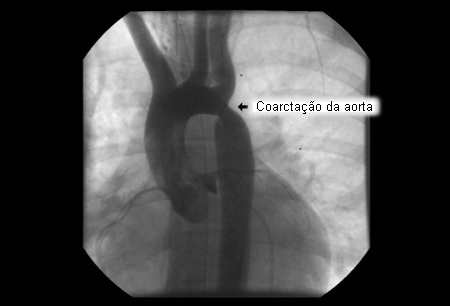Resumo
Definição
História e exame físico
Principais fatores diagnósticos
- hipertensão se apresentando em pouca idade ou resistente ao tratamento
- pulsação dos membros inferiores diminuída
- diferencial na pressão arterial (PA) dos membros superiores e inferiores
Outros fatores diagnósticos
- sopro sistólico de ejeção
- sexo masculino
- síndrome genética
- claudicação
- cefaleia
- clique de ejeção sistólica
- outras anomalias cardíacas
Fatores de risco
- sexo masculino
- idade jovem
- história familiar
- Síndrome de Turner
- Síndrome de DiGeorge
- síndrome do coração esquerdo hipoplásico
- complexo de Shone
- síndrome de PHACE
Investigações diagnósticas
Primeiras investigações a serem solicitadas
- eletrocardiograma (ECG)
- radiografia torácica
- ecocardiograma
Investigações a serem consideradas
- angiografia por tomografia computadorizada (TC)
- ressonância nuclear magnética (RNM)/angiografia por ressonância magnética (ARM)
- cateterismo cardíaco
Algoritmo de tratamento
coarctação crítica
coarctação não crítica
coarctação recorrente
Colaboradores
Autores
Jeffrey Gossett, MD

Vice President and System Chief of Pediatric Cardiology
Professor of Pediatrics
Division of Pediatric Cardiology
Cohen Children’s Medical Center, Northwell Health
New Hyde Park
NY
Declarações
JG declares that he has no competing interests.
Agradecimentos
Dr Jeffrey Gossett wishes to gratefully acknowledge Dr Anna Kamp, a previous contributor to this topic. AK declares that she has no competing interests.
Declarações
AK declares that she has no competing interests.
Revisores
Sheba John, MD, FAAP
Associate Professor
Pediatric Cardiology/Adult Congenital Cardiology
University of Utah
Salt Lake City
UT
Declarações
SJ declares that she has no competing interests.
Daniel A. Cox, DO, FACC, FAAP, FAHA
Associate Professor
Adult Congenital and Pediatric Cardiology
University of Utah/Primary Children's Hospital
Salt Lake City
UT
Declarações
DAC declares that he has no competing interests.
Sachin Khambadkone, MD, DCH, DNB
Consultant Paediatric Cardiologist and Honorary Senior Lecturer
Great Ormond Street Hospital and Institute of Child Health
London
UK
Declarações
SK declares that he has no competing interests.
Créditos aos pareceristas
Os tópicos do BMJ Best Practice são constantemente atualizados, seguindo os desenvolvimentos das evidências e das diretrizes. Os pareceristas aqui listados revisaram o conteúdo pelo menos uma vez durante a história do tópico.
Declarações
As afiliações e declarações dos pareceristas referem--se ao momento da revisão.
Referências
Principais artigos
Erbel R, Aboyans V, Boileau C, et al; Task Force for the Diagnosis and Treatment of Aortic Diseases of the European Society of Cardiology (ESC). 2014 ESC guidelines on the diagnosis and treatment of aortic diseases: document covering acute and chronic aortic diseases of the thoracic and abdominal aorta of the adult. Eur Heart J. 2014 Nov 1;35(41):2873-926.Texto completo
Writing Committee Members, Isselbacher EM, Preventza O, et al. 2022 ACC/AHA Guideline for the diagnosis and management of aortic disease: A report of the American Heart Association/American College of Cardiology Joint Committee on Clinical Practice Guidelines. J Am Coll Cardiol. 2022 Dec 13;80(24):e223-e393.Texto completo Resumo
Baumgartner H, De Backer J, Babu-Narayan SV, et al. 2020 ESC guidelines for the management of adult congenital heart disease. Eur Heart J. 2020 Aug 29;ehaa554.Texto completo
Stout KK, Daniels CJ, Aboulhosn JA, et al. 2018 AHA/ACC Guideline for the management of adults with congenital heart disease: a report of the American College of Cardiology/American Heart Association Task Force on clinical practice guidelines. J Am Coll Cardiol. 2019 Apr 2;73(12):e81-192.Texto completo
Artigos de referência
Uma lista completa das fontes referenciadas neste tópico está disponível para os usuários com acesso total ao BMJ Best Practice.

Diagnósticos diferenciais
- Estenose aórtica (EA)
- Arco aórtico interrompido
- Obstrução do trato de saída do ventrículo esquerdo
Mais Diagnósticos diferenciaisDiretrizes
- ACR appropriateness criteria: congenital or acquired heart disease
- Guidelines for cardiovascular intervention in adults with congenital heart disease
Mais DiretrizesConectar-se ou assinar para acessar todo o BMJ Best Practice
O uso deste conteúdo está sujeito ao nosso aviso legal